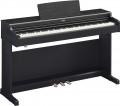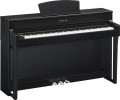Polyphony
The number of voices supported by the digital piano — more precisely, the maximum number of voices that the instrument can play at the same time.
This parameter should not be confused with the number of notes that can be played simultaneously on the keyboard. The fact is that in many timbres, several voices (tone generators) are used for each note at once — this is the only way to achieve a more or less reliable sound. Thus, the required number of voices can be many times higher than the number of notes — for example, the simplest chord of 3 notes may require 9 or even 12 voices. In addition, tone generators are used to play auto accompaniment parts and built-in songs (see below), and here the number of voices can already be measured in tens.
In light of all this, polyphony of less than 90 voices is typical mainly for relatively simple and inexpensive instruments that are not designed for complex tasks. The smallest number found in modern digital pianos is 32 voices. It is desirable for a more or less solid instrument to have at least 96 voices, and in top models this figure can reach 256.
Built-in timbres
The number of built-in sounds provided by the Digital Piano.
Despite the name, digital pianos are extremely rarely designed to imitate the sound of only a piano — the electronic hardware allows them to provide other timbres of sound. In addition, even the piano has its own varieties — for example, among the grand pianos there are 6 main classes, from large concert to miniature. So the built-in sounds can cover different kinds of pianos, as well as other instruments and sound effects.
The abundance and variety of timbres in digital pianos as a whole is not as great as in synthesizers, however, in this category there are very “charged” models, with a hundred timbres or more (in the most multifunctional, this number can exceed 900). However, it is worth specifically looking for a “multi-instrumental” model if you do not intend to be limited to the sound of the piano and would like to have more freedom of choice. It is worth remembering that a specific set of timbres can be different.
If the instrument is bought exclusively as a piano, then here, on the contrary, it is worth paying attention primarily to solutions with a small number of timbres. Such models are not only cheaper than "universals" — they can also sound better (due to the fact that there are few timbres and the manufacturer can carefully approach the sound quality of each built-in "instrument").
Auto accompaniment
Auto accompaniment feature on the digital piano.
Auto Accompaniment is a melody of a specific style played by the instrument under user control. Such control is carried out by the left hand: the musician takes certain chords on the left side of the keyboard, and the electronics of the instrument adjusts the auto accompaniment melody to the key of the taken chord. Thus, this function allows you to accompany the main part with a full-fledged accompaniment, while the musician only needs to set the chords.
Among digital pianos, unlike synthesizers, this function is rare. This is due to the general specialization of this class of instruments (not least professional music-making, including as part of an ensemble or orchestra). However, auto accompaniment is available on both relatively simple and high-end digital pianos.
Accompaniment styles
The number of Auto Accompaniment Styles (see above) originally stored in Digital Piano memory.
Different auto accompaniment styles differ from each other in the same way that different melodies differ from each other — in tempo, time signature, rhythmic pattern, set of instruments used, etc. Accordingly, the more styles initially available in the instrument, the wider the choice of the musician and the higher the probability of finding the option that best suits a particular situation. However even numerous styles does not guarantee that among them there will be a suitable one; in addition, we note that with the same number of styles, their specific set in different instruments can also be different. However, custom styles can be provided for this case (see below).
Summarizing, we can say this: if you plan to work intensively with auto accompaniment, in addition to the number of styles, it will not hurt to clarify their specific range.
Learning mode
The presence of a training mode in the digital piano.
As the name suggests, this mode is designed to teach the game. At the same time, usually, it provides different levels of difficulty — from the most basic, for those who are just starting to master the "keys", to the advanced one, which allows you to train your technique and improve your existing performance skills. However, anyway, the principle of learning is the same: the tool independently tells the student which keys to press at one time or another. Such hints can be in the form of a backlight (see above) or as a graphic on the display. Such a method is doubtful from the point of view of classical academic learning, however, it is undoubtedly more convenient and faster than reading musical notation. Moreover, the instrument can also play the role of an examiner — launch prompts at the original tempo of the melody and check how accurately the student hits the notes.
Also note that
the learning mode requires the obligatory presence of a metronome (see below).
Tempo change
The range over which the tempo of the sound played by the instrument can change. It can be either a built-in melody or a part recorded on a sequencer, or an auto accompaniment, a tutorial or a metronome. For more information on all of these features, see the corresponding glossary entries. Here we note that a change in tempo is often required in fact — for example, to speed up an initially "sluggish" accompaniment or slow down a training programme that is difficult to master at the original tempo.
Tempo is traditionally indicated in beats per minute. The classical, "academic" range covers options from 40 bpm ("grave", "very slow") to 208 bpm ("prestissimo", "very fast"), however, in modern digital pianos, the working range of tempos is often significantly wider.
Chorus
The presence of the chorus effect in the digital piano.
Initially, this effect was developed as an attempt to simulate the choral sound of several instruments of the same type. Even a perfect choir never plays 100% in sync, which is what the creators of the chorus tried to reproduce. This effect works as follows: several copies are taken from the main signal, which are played along with it — but not strictly simultaneously, but with a small (up to 30 ms) delay, selected randomly for each individual signal. This really allows to imitate the effect of polyphony to a certain extent, however, such sound is still far from a full-fledged choir. However, the
chorus itself is quite interesting as an additional effect.
Brightness
The ability to change the
brightness of the sound of certain timbres or tracks.
Brightness determines the overall colour of the sound — from soft, smoothed to sonorous, sharp. This feature allows the player to adjust this coloration to their preference, and thus further expands the possibilities for customizing the sound of the instrument.
More features
Additional features and sound customization options provided by the instrument in addition to those listed above. In this paragraph, usually, various original proprietary technologies and solutions are indicated; the specific meaning of these functions is best specified in the documentation for the tool.

